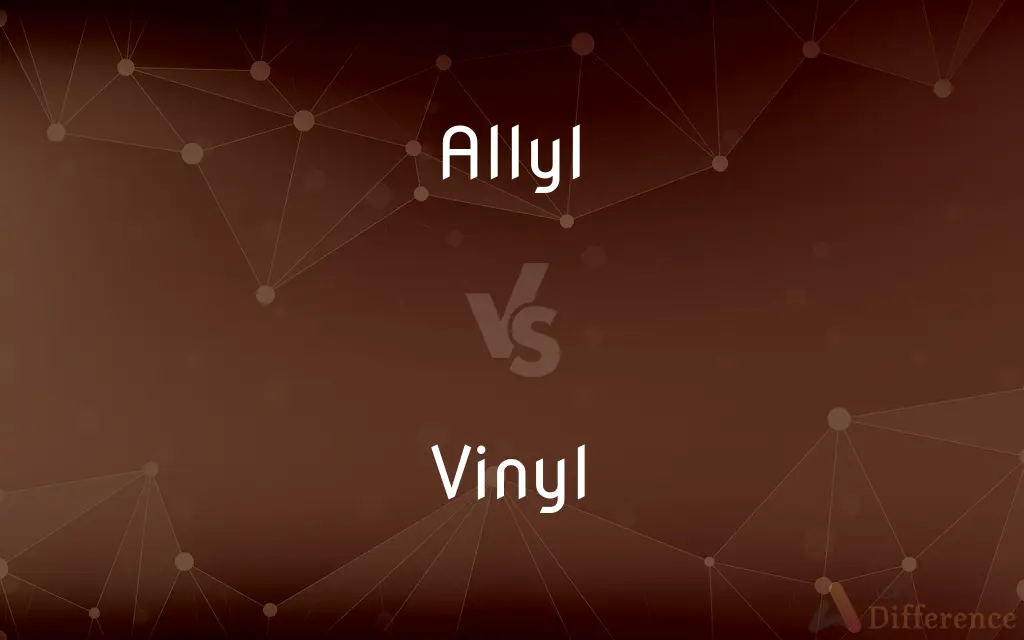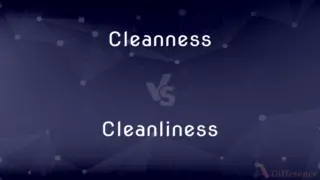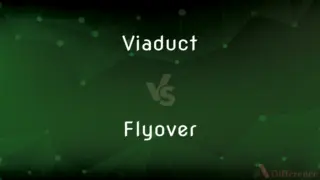Allyl vs. Vinyl — What's the Difference?
By Tayyaba Rehman — Updated on September 20, 2023
Allyl is a functional group with the structure H2C=CH-CH2-, while Vinyl is a functional group with the structure H2C=CH-. Both are derived from alkenes.

Difference Between Allyl and Vinyl
Table of Contents
ADVERTISEMENT
Key Differences
Allyl and Vinyl are functional groups in organic chemistry that find application in various compounds. Allyl consists of three carbon atoms connected in a sequence, while Vinyl has just two carbon atoms bonded by a double bond.
The molecular structure of Allyl is H2C=CH-CH2-, meaning it has a double bond between the first two carbons and a single bond to a third carbon. In contrast, Vinyl has the structure H2C=CH-, representing only a double bond between its two carbons.
Both Allyl and Vinyl are unsaturated, containing carbon-carbon double bonds. However, the position and the number of these bonds differ. While Vinyl is directly involved in the double bond, Allyl has one carbon separated from the double bond.
In terms of reactivity, Allyl compounds are more versatile due to their longer carbon chain. They can undergo a range of reactions that Vinyl compounds can't. For example, allylic bromination is a common reaction for Allyl but not for Vinyl.
Common compounds containing the Allyl group include allyl alcohol and allyl chloride. Vinyl compounds include vinyl chloride, which is used to produce PVC or polyvinyl chloride.
ADVERTISEMENT
Comparison Chart
Definition
3-carbon functional group.
2-carbon functional group.
Structure
H2C=CH-CH2-
H2C=CH-
Bonding
One double, one single bond.
One double bond.
Reactivity
More versatile reactions.
Limited due to shorter chain.
Examples
Allyl alcohol, allyl chloride.
Vinyl chloride, vinyl acetate.
Compare with Definitions
Allyl
Unsaturated Chain: Contains a carbon-carbon double bond.
The allyl group's double bond contributed to its reactivity.
Vinyl
2-Carbon Group: A functional group derived from ethylene.
The polymer was made of repeating vinyl units.
Allyl
Versatile Reactivity: Can undergo various organic reactions.
The compound underwent an allyl bromination.
Vinyl
Base for PVC: Used in creating polyvinyl chloride.
Vinyl chloride is a precursor to PVC.
Allyl
Present in Organic Compounds: Found in multiple chemicals.
Allyl chloride is an important industrial chemical.
Vinyl
Direct Double Bond: Contains a carbon-carbon double bond directly.
The vinyl group's double bond made it unsaturated.
Allyl
Separated Double Bond: The double bond is not at the end.
The allyl group's unique structure allows for diverse reactions.
Vinyl
Synthetic resin or plastic consisting of polyvinyl chloride or a related polymer, used for wallpapers and other covering materials and for gramophone records
The vinyl is cut to size with a craft knife
Vinyl floor tiles
Allyl
3-Carbon Group: A functional group derived from propylene.
The molecule had an allyl group attached to its ring.
Vinyl
Of or denoting the unsaturated hydrocarbon radical —CH=CH₂, derived from ethylene by removal of a hydrogen atom
A vinyl group
Allyl
The univalent, unsaturated organic group C3H5.
Vinyl
The univalent hydrocarbon group CH2=CH, derived from ethylene.
Allyl
The univalent radical, CH2=CH-CH2-, existing especially in oils of garlic and mustard.
Vinyl
Any of various compounds containing the vinyl group, typically highly reactive, easily polymerized, and used as basic materials for plastics.
Allyl
An organic radical, C3H5, existing especially in oils of garlic and mustard.
Vinyl
Any of various typically tough, flexible, shiny plastics, often used for coverings and clothing.
Allyl
The univalent unsaturated organic radical C3H5; derived from propylene
Vinyl
Phonograph records considered as a group
A secondhand store that buys and sells vinyl.
Vinyl
The univalent radical CH2=CH−, derived from ethylene.
Vinyl
(countable) Any of various compounds and substances containing the vinyl radical, especially various tough, flexible, shiny plastics.
Vinyl
Phonograph records as a medium.
Many DJs prefer vinyl to CDs.
Vinyl
A phonograph record.
Vinyl
(chemistry) Containing the vinyl radical.
Vinyl
Made of polyvinyl chloride.
Vinyl
(music) Pertaining to a phonograph record.
Vinyl
The hypothetical radical C2H3, regarded as the characteristic residue of ethylene and that related series of unsaturated hydrocarbons with which the allyl compounds are homologous.
Vinyl
A univalent chemical radical derived from ethylene
Vinyl
Shiny and tough and flexible plastic; used especially for floor coverings
Vinyl
Common in Plastics: Found in various plastic materials.
The vinyl record was made of a specific type of plastic.
Vinyl
Unsaturated Group: Lacks hydrogen for saturation.
The presence of the vinyl group added rigidity to the polymer.
Common Curiosities
Are both groups derived from alkenes?
Yes, allyl from propylene and vinyl from ethylene.
Are allyl and vinyl the same?
No, allyl has three carbons, while vinyl has two.
Which group is more reactive?
Allyl generally has more versatile reactivity due to its structure.
What's the primary use of vinyl chloride?
Vinyl chloride is used to produce PVC.
Is the double bond in allyl directly involved in reactions?
Not always. Some reactions involve the carbon separated from the double bond.
Are compounds with these groups hazardous?
Some compounds, like vinyl chloride, have associated health risks.
Can allyl groups undergo oxidation?
Yes, allyl groups can be oxidized to produce compounds like carboxylic acids.
Can both groups be found in plastics?
Yes, but vinyl, especially in the form of PVC, is more commonly associated with plastics.
Can both allyl and vinyl be found in nature?
While both can be synthesized, they are not commonly found in natural compounds.
What makes vinyl important in the plastic industry?
Vinyl is a key component in PVC, a widely-used plastic.
Are allyl and vinyl polar or nonpolar?
Both groups are nonpolar due to their carbon-carbon bonds.
Are there any natural sources of vinyl compounds?
Some plants produce vinyl compounds, but they're more commonly synthesized.
Is vinyl used in clothing?
Yes, vinyl is used in synthetic leathers and other materials.
What is the origin of the word 'vinyl'?
It comes from the Latin word for wine, due to its relation to ethyl alcohol.
What's a common reaction for vinyl?
Polymerization is a common reaction, producing materials like PVC.
Share Your Discovery

Previous Comparison
Cleanness vs. Cleanliness
Next Comparison
Viaduct vs. FlyoverAuthor Spotlight
Written by
Tayyaba RehmanTayyaba Rehman is a distinguished writer, currently serving as a primary contributor to askdifference.com. As a researcher in semantics and etymology, Tayyaba's passion for the complexity of languages and their distinctions has found a perfect home on the platform. Tayyaba delves into the intricacies of language, distinguishing between commonly confused words and phrases, thereby providing clarity for readers worldwide.















































